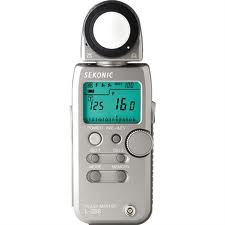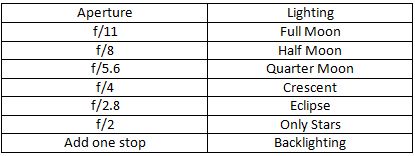Sunny 16 Rule - Photography Rules
Sunny 16 Rule
This is a method used in photography to estimate the right exposure without the light meter. It is mostly used on daytime or a sunny day when light is directly hitting the subject with sharp distinct shadows.

A light meter is used to measure light meter is used to measure the amount of light which in turn will help you determine the right exposure. Advanced still and video cameras use an in-built light meter to approximate the right exposure based on the lighting at the scene. But professional photographers still use a handheld light meter to accurately measure light falling on different parts of the subject to produce the desired exposure.
The sunny 16 Rule provides a method you can use to help you achieve the right exposure without a light meter. The in-built light meters are measure the light reflected from the subject while the sunny 16 rule measure the incident light coming from the light source.
The rule states that -: On a sunny day set aperture to f/16 and shutter speed to the reciprocal of the ISO.

If the shutter speed values do not correspond with the values of the ISO, the best way is to set the shutter speed to the nearest reciprocal value. E.g. ISO 200, shutter speed 1/250.
Now you may be asking yourself why you would need to apply such in your photography whereas you can just keep things simple. But understanding how your camera works even when in auto mode will definitely help you improve your knowledge.
But what is now you want to change the depth of field using the aperture or achieve motion blur/freeze moving objects using the shutter speed. If you widen the aperture by one stop, you double the shutter speed and vice versa. Thus setting aperture of f/8, 1/200 and f/11, 1/100 produces the same exposure with the latter having increased depth of field. This is because the smaller lens aperture (f/11) reduces the light by half and the slower shutter speed (1/100) doubles the time during which light exposes the camera sensor. Although at very fast and very slow shutter speed this reciprocity fails to work e.g. a shutter speed slower than 1 second or faster than 1/2000.
In this case you give more exposure than the meter indicates, either by setting a larger aperture or slow the shutter speed. You may also increase the sensitivity of the ISO.

Change of weather? Yes
The sunny 16 rule is probably the one that will give you the right exposure under a bright sun with very distinct shadows on the subjects. If you feel the shadows are getting soft due to decrease in the sunlight then you need to make adjustments to the aperture.
So, in other conditions when it not a sunny situation , the change in aperture occurs which in turn lead to change in shutter speed. The f-stop and shutter speed have a reciprocal relationship. If you change either setting, you must change the other in the opposite direction for an equivalent exposure.
See the table below -:

Other Rules
Looney 11 Rule
This is a method used in photography to estimate the right exposure without the light meter at night. It is used to shoot the moon surface referred as lunar photography. There is a similar rule used to shoot subjects during the day called Sunny16 rule. There is a difference between lunar photography and moonlight photography, the latter means shooting subjects on the earth’s surface that are illuminated by the moonlight.
The Rule states that ‘’for astronomical photos of the moon's surface, set aperture to f/11 and shutter speed to the reciprocal of the ISO’’.

In other lighting conditions, see the table below :-

NB://(mathematical relationship between aperture and exposure time — within reasonable ranges,
exposure is proportional to the square of the aperture ratio and proportional to exposure time; thus, to maintain a constant level of exposure, a change in aperture by a factor c requires a change in exposure time by a factor 1/c² and vice versa) - Wikipedia
1/125, f/16 = 1/250, f/11



